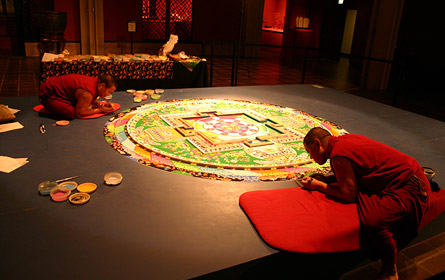|

Monks of Gaden Lhopa Khangtsen monastery
One element of The Circle of Bliss
exhibition is the on-site creation of a seven-foot-diameter sand mandala of Chakrasamvara by Tibetan Buddhist
monks from the Gaden Lhopa Khangtsen monastery in India. This particular sand mandala has never before been made in
the United States.
Spiritual Processing:
Creation of the sand mandala
His Holiness the Fourteenth Dalai Lama has often said that we may also imagine
the outer mandala representing the planet earth, the solar system, the galaxy, or
the universe, as modern science conceives of them today. It makes no difference.
The point is that offering a mandala represents the willingness to give everything
in the universe to receive teachings, vows, or empowerment.
The purposeful arrangement of individual atoms bears some resemblance to
the methods monks use to laboriously create sand images particle by particle,
however, Eastern and Western cultures use these bottom-up building practices
with very different perceptions and purposes. This installation incorporates
a mandala (a cosmic diagram and ritualistic symbol of the universe, used in
Hinduism and Buddhism, which can be translated from Sanskrit as "whole",
"circle" or "zero") Visitors watch as images of a grain of sand are projected in
evolving scale from the molecular structure of a single grain to the recognizable
image of a pile of sand. On the atomic scale the sand particles are like atoms,
but a thousand of times smaller. From a bottom-up method of visual image
building, a sand mandala slowly emerges.
Chakrasamvara mandala
Refers to the mandala representing the 'temple-palace' housing the conclave
of sixty-two deities presided over by Chakrasamvara and the consort-dakini
Vajravarahi. The temple-palace and its dwellers are equally symbolic of the
highest reality, which the Buddha's Dharmakaya is capable of projecting outward.
Chakrasamvara and Vajravarahi embody the enlightened Buddhas of the Highest
Yoga Tantras, whose symbolism and meditation are intended to lead the Tantric
practitioner directly to enlightenment within this lifetime. To realize the state of
enlightenment, the Chakrasamvara practice places special emphasis on the
attainment of the radiant light of bliss (prabhasvara) that is generated through
the union of Chakrasamvara and Vajravarahi. This process is called devayoga,
literally meaning "uniting with the gods," in which the yogin acquires the qualities
of the visualized beings and therefore understands his or her identity with the
fully realized Buddhas.
The meditation begins by visualizing the glorious body of Chakrasmavara, and
completes with the visualizations of Vajravarahi, as the inner purifying fire.
Through this process, the meditator experiences the great bliss (mahasukha) of
complete enlightenment. This state of absolute nonduality-the cessation of all
desire and quiescence of all egoistic constructs-is nowhere more powerfully
symbolized than by the union of Chakrasamvara and Vajravarahi. Their eternal
and indivisible union forcefully unites wisdom and compassion into a completely
realized state of nonduality. Within their one enlightened mind, there is only
altruistic compassion and complete insight into the Dharma. The method is to
imagine a sequence of stages and transformations and to practice them
repeatedly until they are completely internalized. At each stage, the works of art
aid the the practitioner to understand the iconography and interpretive
symbolism of Chakrasamvara/Vajravarahi as well as the sixty-two deities of the
Chakrasamvara mandala.
|
 |

Monks at NANO retreat:





Chakrasamvara sand mandala completed:

Ending Ceremony:





|
